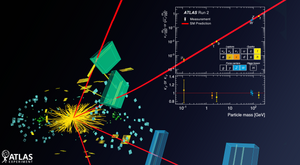Press releases

A glimpse of the ATLAS Collaboration – representing just a small part of the 13,508 people awarded the 2025 Breakthrough Prize. (Source: CERN)
The „Oscar of Science“ goes to... Breakthrough Prize 2025 for ATLAS Collaboration
The ATLAS Collaboration was honored for its pioneering studies of the high-energy collisions from the Large Hadron Collider (LHC). The Breakthrough Prize specifically highlights ATLAS’ detailed measurements of Higgs boson properties, studies of rare processes and matter-antimatter asymmetry, and its exploration of nature under the most extreme conditions. ATLAS shares the award with the ALICE, CMS and LHCb Collaborations at CERN.
Contribution of the MPP

“Our institute is not only a founding member of ATLAS in 1992, but also one of the principal proponents of the experiment more than three decades ago“, says Marumi Kado, director at the MPP and former ATLAS deputy spokesperson. “Since then the institute has played a leading role in the project design, the construction, the commissioning, the operations of the detector, and the data analysis.” The data analyses carried out at the MPP have been key to deepening the understanding of the Higgs boson, scientists have precisely measured its mass, studied its dominant production and decay modes, and created a detailed map of its interactions with other elementary particles.
MPP researchers have also led the precision measurement of the top quark mass, achieving the world’s most accurate result to date, in combination with the CMS experiment. The institute has played a leading role in many of the searches for new particles, including additional Higgs bosons, dark matter particles, and supersymmetric particles. In addition, it has been instrumental in the design, construction, and operation of key subsystems, as well as in the precise reconstruction of collision products.
“The prestigious Breakthrough Prize recognises a remarkably collective effort and collaboration that made significant progress in our understanding of the fundamental laws of nature“, Marumi Kado emphasizes. „It is an important tribute to the dedication not only of all the scientists having worked in ATLAS at the institute, but also to the engineers, technicians and administrative staff, without whom none of this would have been possible.”
Future perspectives
At the MPP, a dedicated team of around 50 scientists, students and engineers is preparing several upgrades of the ATLAS detector for its next chapter, set to begin in 2030: the challenging High Luminosity phase of the LHC, which will increase collision rates by a factor of four. As part of these upgrades, the team is enhancing the muon detection system with state-of-the-art gaseous particle detectors and improved data filtering technology, enabling more efficient identification of signals. They are also playing a leading role in the development and production of cutting-edge silicon pixel detectors for the upgraded particle tracking system. In addition, the team is delivering advanced low-voltage power supplies to support the precise measurement of particle energy deposits in the calorimeter system.
Looking into the future, the Breakthrough Prize – through the CERN & Society Foundation – will help fund PhD scholarships, fostering the next generation of ATLAS scientists to continue the legacy of discovery.
About ATLAS
As a general-purpose particle detector measuring over 40 meters in length and around 25 meters in height, ATLAS is designed to explore the fundamental building blocks of matter and the forces that govern our universe. Its advanced systems track particles produced in particle collisions at unprecedented energies, enabling discoveries like the Higgs boson, precision measurements of Standard Model fundamental parameters and searches for new physics beyond the Standard Model.